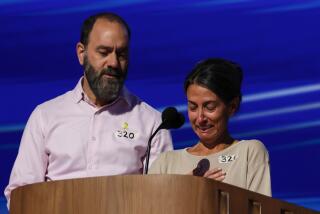Serene Wedding Fest, Then a Pit of Death
- Share via
JERUSALEM — The guests are dancing to a very popular, bouncy Mizrahi tune, pretty women in sleek dresses, a baby on her father’s shoulders, young thin men. They smile, sing along to the words; a woman in blue adjusts her straps.
Suddenly, seemingly in unison, they plunge, disappearing into a dark pit of death that fills with dust and screams. There is no warning, no time for the vanishing faces to grasp that they are being swallowed.
An amateur photographer was videotaping the festive wedding of Keren and Assaf Dror on Thursday night when the top floor of a four-story Jerusalem banquet hall collapsed, crushing hundreds and killing at least 24. As many as 23 people were still missing late Friday, police said, as rescuers grimly worked through the Jewish Sabbath excavating the wreckage.
A horrified Israel was grappling Friday with tragedy on multiple fronts: Another spasm of political terror with two suicide bombings that injured dozens, and the wedding hall disaster, blamed on shoddy construction and possibly criminal negligence.
Two Palestinians loaded explosives into a car and plowed into a crowded bus Friday afternoon in the coastal town of Hadera. They managed to blow themselves up and injure as many as 63 Israelis, most of them bus passengers. None of the Israelis were seriously hurt, but it was the latest in a vicious spate of terror bombings since Israeli-Palestinian clashes erupted eight months ago.
Earlier Friday, another suicide bomber belonging to the radical Islamic Hamas movement tried to drive a truck full of explosives into a fortified Israeli army post in the Gaza Strip. Israeli soldiers opened fire and the truck exploded, killing the driver. In what is becoming a familiar ritual, the man left behind a videotape in which he announced his intention to kill Israelis.
Despite the violence, Israeli Prime Minister Ariel Sharon--who has responded to earlier bombings with airstrikes against Palestinian targets--reiterated his call this week for a cease-fire and urged Palestinian Authority President Yasser Arafat to join. Sharon spoke after visiting the site of the collapsed wedding hall, which authorities say was Israel’s worst civil disaster in its 53-year history.
Police officials launched a criminal investigation into the disaster and arrested at least four people--several builders and the inventor of the material used for flooring. Police hinted that they would also question officials in City Hall, where the building permits were issued.
Israel is tragically inured to death and destruction, but the wedding hall disaster hit an especially raw nerve, perhaps because so many people were struck down on the happiest of occasions--and when many were probably thankful to have a rare night of escape from the daily harsh reality.
Israeli television dedicated nearly round-the-clock coverage to the slow recovery operation at the Versailles banquet hall in Jerusalem’s industrial Talpiot neighborhood. One anchor choked up as she read the names of the dead who have been identified; their ages ranged from 3 to 76.
“It is a hard day, a day of pain, and we all need to stand together,” Sharon said.
Israelis also were demanding answers to what happened. They like to think of this as the most modernized country in the region, but questionable building codes and slipshod construction practices abound, experts and officials said.
The hall’s top floor, where members of the Dror wedding party were dancing, gave way and caved onto the floors below, which stacked like pancakes as each collapsed. Two walls on opposite sides then fell into the crater and atop the struggling, gasping people.
On Friday afternoon, the recovery teams, many skilled from earthquake rescue missions in Turkey, Armenia and elsewhere, continued their work in precarious rubble with little hope of finding additional survivors.
Of the dead pulled out Friday, two were a couple, their bodies found still locked in an embrace.
The scale of the destruction revealed the poor quality of the construction and appeared to confirm an army engineer’s assessment that it was substandard. Thin spindly rods--not reinforced bars--poked out from concrete flooring that seemed to have simply peeled away. The floors and ceilings were made of thin, sandy concrete laid over metal mesh in some places and corrugated metal plates in others.
Building industry specialists said the techniques used were popular in the 1980s but outlawed five years ago. Eli Ron, an engineer who heads the company that manufactures the flooring material, insisted that it had passed stress tests. Ron was speaking in a radio interview early Friday--before his arrest later in the day.
There also were reports that support beams in a lower floor had been removed for a renovation project. Tenants said water leaks may have weakened the structure.
The Versailles hall was built in 1986, and Jerusalem Mayor Ehud Olmert told a news conference that preliminary examination of the building file disclosed irregularities. But he would not elaborate.
Aharon Cohen, chairman of the Jerusalem contractors association, told Israeli radio that the building was planned as an industrial facility, not a banquet hall, and may never have been retrofitted to withstand the heavy concentration of weight in certain areas, such as dance floors.
However, Abraham Abramovich, a leading commentator on Israeli television, may have done the best job of summing up the national outrage over the disaster.
“ ‘Engineering failure’ is such a sterile description,” he said angrily, noting that businesses invest more in obtaining kosher certificates than in basic safety codes. “We live in a culture of corruption that always takes the shortcuts.”
Anger--and solidarity. So many Israelis turned up at hospitals in the middle of the night responding to an urgent appeal for blood that relief officials suspended the call after collecting 900 pints.
Four of the dead apparently belonged to the groom’s family. He suffered cuts; his bride was awaiting pelvic surgery. She tearfully pleaded from her bed that the guests forgive her, Israeli radio reported.
“I remember the whole fall--first the first floor, then the second, then the third,” the groom’s mother, Alize Srur, said Friday from her hospital bed. In the videotape, she is seen in a black evening gown being lifted in a chair over the dancing crowd, a traditional custom at Jewish weddings.
“I saw people die,” she said. “The lower part of my body was trapped, but I was conscious and it seemed an eternity before the teams reached me. They didn’t even know where to start at first.
“How can something like this happen in our country?” she said over and over.
Shai Kenon, 30, his arm in a cast, recalled his good friend who died during a series of terrorist bus bombings in 1996. “Since then, my friends and I are very careful, always looking around to avoid trouble,” he said quietly from his hospital bed. “Isn’t it enough that we run into [this] from our cousins [the Palestinians] that we also have to run into trouble of our own doing?”
It was particularly disturbing to Israelis to see the videotape, providing a glimpse of people’s faces as they fell to their deaths. The gut-wrenching images were broadcast repeatedly on Israeli television.
The cameraman, David Amromin, said the people on the dance floor had sunk about 2 feet before he realized what was happening. Then they disappeared, and the screams began. Children cried out, “Imma! Abba! [Mom! Dad!]” Adults cried out names and begged for help.
“My camera was filming without me,” he said. “I remember it all too well. I don’t think I can forget it any time soon.”
In the video, the jubilant dancers are singing along to “I Have a Heart of Gold,” by Sarit Hadad, a popular performer of Mizrahi, or Middle Eastern Jewish music. Just as they start to sink, they are heard singing the refrain: “I have no money, I have no future.” And then they are gone.
*
MORE ONLINE
Video: The amateur video of the wedding hall collapse is available on The Times’ Web site at https://www. latimes.com/collapse.
More to Read
Sign up for Essential California
The most important California stories and recommendations in your inbox every morning.
You may occasionally receive promotional content from the Los Angeles Times.











